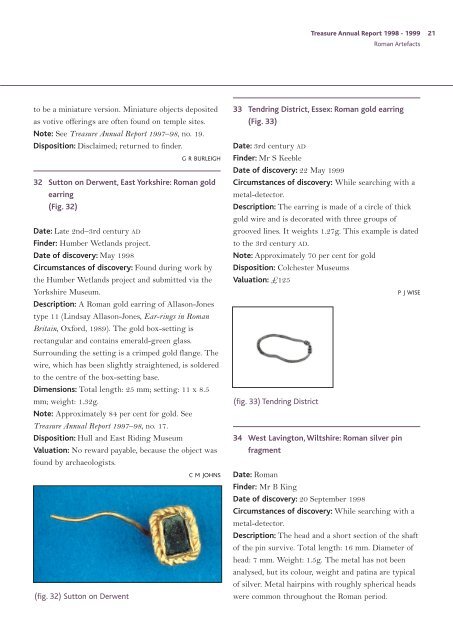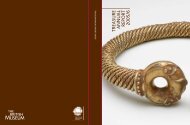Treasure Annual Report 1998-1999 - Portable Antiquities Scheme
Treasure Annual Report 1998-1999 - Portable Antiquities Scheme
Treasure Annual Report 1998-1999 - Portable Antiquities Scheme
Create successful ePaper yourself
Turn your PDF publications into a flip-book with our unique Google optimized e-Paper software.
to be a miniature version. Miniature objects deposited<br />
as votive offerings are often found on temple sites.<br />
Note: See <strong>Treasure</strong> <strong>Annual</strong> <strong>Report</strong> 1997–98, no. 19.<br />
Disposition: Disclaimed; returned to finder.<br />
G R BURLEIGH<br />
32 Sutton on Derwent, East Yorkshire: Roman gold<br />
earring<br />
(Fig. 32)<br />
Date: Late 2nd–3rd century AD<br />
Finder: Humber Wetlands project.<br />
Date of discovery: May <strong>1998</strong><br />
Circumstances of discovery: Found during work by<br />
the Humber Wetlands project and submitted via the<br />
Yorkshire Museum.<br />
Description: A Roman gold earring of Allason-Jones<br />
type 11 (Lindsay Allason-Jones, Ear-rings in Roman<br />
Britain, Oxford, 1989). The gold box-setting is<br />
rectangular and contains emerald-green glass.<br />
Surrounding the setting is a crimped gold flange. The<br />
wire, which has been slightly straightened, is soldered<br />
to the centre of the box-setting base.<br />
Dimensions: Total length: 25 mm; setting: 11 x 8.5<br />
mm; weight: 1.32g.<br />
Note: Approximately 84 per cent for gold. See<br />
<strong>Treasure</strong> <strong>Annual</strong> <strong>Report</strong> 1997–98, no. 17.<br />
Disposition: Hull and East Riding Museum<br />
Valuation: No reward payable, because the object was<br />
found by archaeologists.<br />
(fig. 32) Sutton on Derwent<br />
C M JOHNS<br />
<strong>Treasure</strong> <strong>Annual</strong> <strong>Report</strong> <strong>1998</strong> - <strong>1999</strong> 21<br />
Roman Artefacts<br />
33 Tendring District, Essex: Roman gold earring<br />
(Fig. 33)<br />
Date: 3rd century AD<br />
Finder: Mr S Keeble<br />
Date of discovery: 22 May <strong>1999</strong><br />
Circumstances of discovery: While searching with a<br />
metal-detector.<br />
Description: The earring is made of a circle of thick<br />
gold wire and is decorated with three groups of<br />
grooved lines. It weights 1.27g. This example is dated<br />
to the 3rd century AD.<br />
Note: Approximately 70 per cent for gold<br />
Disposition: Colchester Museums<br />
Valuation: £125<br />
(fig. 33) Tendring District<br />
34 West Lavington, Wiltshire: Roman silver pin<br />
fragment<br />
P J WISE<br />
Date: Roman<br />
Finder: Mr B King<br />
Date of discovery: 20 September <strong>1998</strong><br />
Circumstances of discovery: While searching with a<br />
metal-detector.<br />
Description: The head and a short section of the shaft<br />
of the pin survive. Total length: 16 mm. Diameter of<br />
head: 7 mm. Weight: 1.5g. The metal has not been<br />
analysed, but its colour, weight and patina are typical<br />
of silver. Metal hairpins with roughly spherical heads<br />
were common throughout the Roman period.





